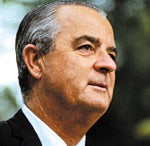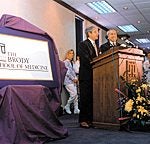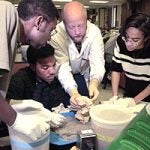Two incredible decades: 20 years of graduates and 20 years of growth

Jenkins
Bill Brown was among the medical students who arrived at ECU in August 1977. They were eager students, and the community embraced them. Dinner invitations came frequently, though they were often declined because studies came first. Fellow students examined their coming and going, and news reporters interviewed them. They were the biggest headline grabbers that fall, and it felt good.
“I remember being glad to be in medical school, glad to have the opportunity to be there,” Brown said. “The forefathers worked diligently to put this together, to meet all the requirements and make it an excellent school. Then, it multiplied and you watched it go from an empty field to a major building. You felt honored to have been there.”
From the early 1960s, when ECU Chancellor Leo W. Jenkins first proposed a medical school, to the year of the first graduating class almost 20 years later, many forces came together to create a distinctive institution that continues to serve as a model for the nation. The affiliation agreement with Pitt County Memorial Hospital established a solid working alliance between the hospital and the medical school and between academic and private-practice physicians. Above all, the school’s three-part mission ” educate primary care physicians, increase opportunities for minority and disadvantaged students and provide health care for the region” has provided the guidance for its accomplishments and success.
“Today, twenty years later, we have graduated 1,343 medical doctors and 95 Ph.D. students and have trained 832 physicians in our residency programs,” said Dr. Peter Kragel, interim dean of the medical school. “This has all been accomplished with a clear focus on our mission: to improve health care in eastern North Carolina.”
May 8, 1981
Dressed in black commencement robes among the hundreds of ECU graduates receiving degrees in Minges Coliseum on May 8, the young doctors received thunderous applause, cheers and a standing ovation from the other graduates, the audience and state leaders in attendance.
Meanwhile, three classes behind them moved up and a new class entered in a chain of education and graduation that has produced more than a thousand doctors, with just over 26 percent of them in family medicine and about 62 percent in primary care.
By the first graduation, construction was under way on the new School of Medicine building. Earlier in 1981, the Liaison Committee on Medical Education gave full accreditation to the school. The first graduate programs began in 1979 in anatomy, biochemistry, microbiology, pharmacology and physiology, bringing the school another vital component in research, education and service.
By 1982, the new medical school building opened. Its nine stories contained classrooms, laboratories, conference rooms, lounges and offices. It was named the Brody Medical Sciences Building to honor the long-standing support of the Brody families of Greenville and Kinston.
The Brody Building provided more than educational space. It also housed one of the largest outpatient centers in the East. With 70 treatment rooms, the Brody Outpatient Center provided services in internal medicine, OB-GYN, psychology, pediatrics and surgery.
Within a year, a new residency program began in emergency medicine, and PCMH began developing its trauma center. In 1985, the hospital became a Level I trauma center.
In other areas, too, the health care mission moved forward. The Radiation Therapy Center, now the Leo W. Jenkins Cancer Center, opened in 1984.
- From left, Hyman and David Brody talk about their family’s $8 million gift to the medical school Dec. 7, 1999.
- Physiology professor Dr. Richard Ray, center, works with students in a teaching lab. In addition to its medicine program, the medical school has offered doctorates in six biomedical sciences since 1979. Photo by Cliff Hollis
Contact: Doug Boyd | 252-744-2481

